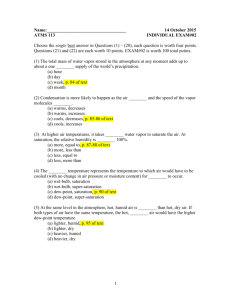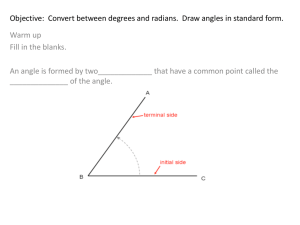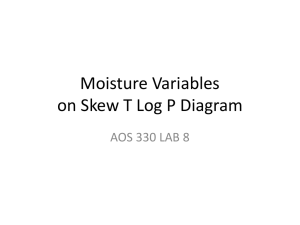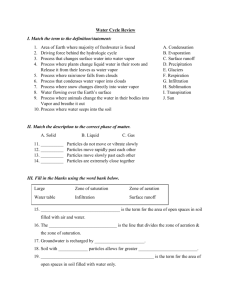Laboratory Exam I
advertisement
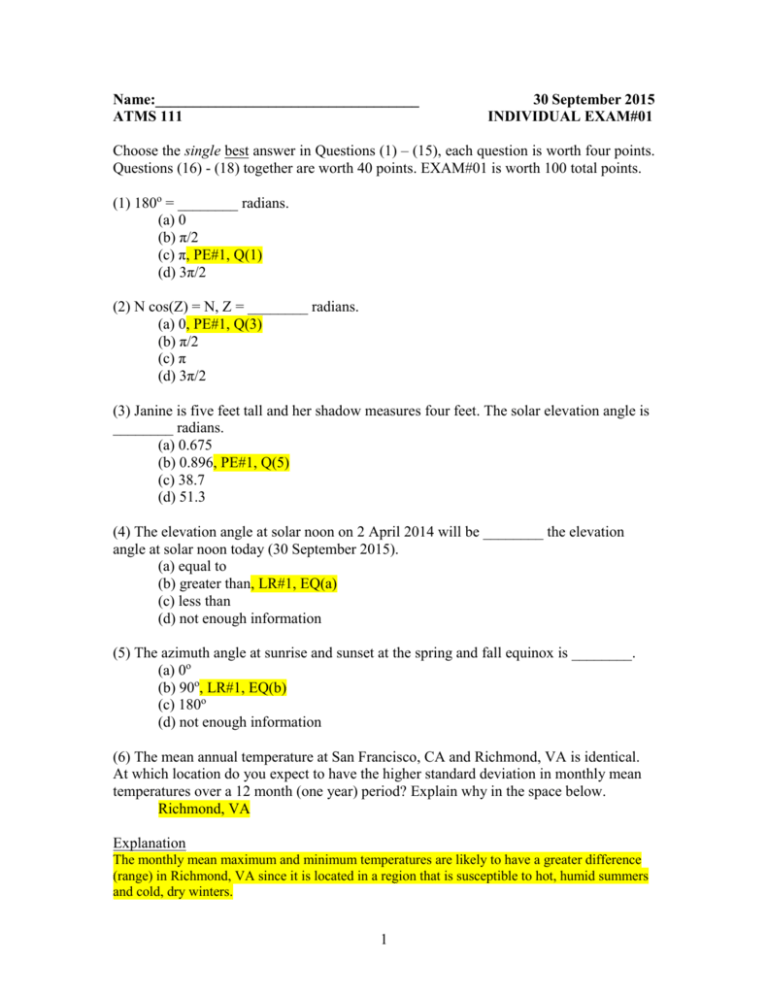
Name:___________________________________
ATMS 111
30 September 2015
INDIVIDUAL EXAM#01
Choose the single best answer in Questions (1) – (15), each question is worth four points.
Questions (16) - (18) together are worth 40 points. EXAM#01 is worth 100 total points.
(1) 180o = ________ radians.
(a) 0
(b) π/2
(c) π, PE#1, Q(1)
(d) 3π/2
(2) N cos(Z) = N, Z = ________ radians.
(a) 0, PE#1, Q(3)
(b) π/2
(c) π
(d) 3π/2
(3) Janine is five feet tall and her shadow measures four feet. The solar elevation angle is
________ radians.
(a) 0.675
(b) 0.896, PE#1, Q(5)
(c) 38.7
(d) 51.3
(4) The elevation angle at solar noon on 2 April 2014 will be ________ the elevation
angle at solar noon today (30 September 2015).
(a) equal to
(b) greater than, LR#1, EQ(a)
(c) less than
(d) not enough information
(5) The azimuth angle at sunrise and sunset at the spring and fall equinox is ________.
(a) 0o
(b) 90o, LR#1, EQ(b)
(c) 180o
(d) not enough information
(6) The mean annual temperature at San Francisco, CA and Richmond, VA is identical.
At which location do you expect to have the higher standard deviation in monthly mean
temperatures over a 12 month (one year) period? Explain why in the space below.
Richmond, VA
Explanation
The monthly mean maximum and minimum temperatures are likely to have a greater difference
(range) in Richmond, VA since it is located in a region that is susceptible to hot, humid summers
and cold, dry winters.
1
Name:___________________________________
ATMS 111
30 September 2015
INDIVIDUAL EXAM#01
Six measurements of air temperature [Kelvin] at UNC Asheville yield the following;
295 K, 297 K, 301 K, 300 K, 296 K, 299 K
Use these observations to help answer Questions (7) and (8).
(7) The average (or mean) air temperature for the measurements made at UNC Asheville
is ________.
(a) 295 K
(b) 296 K
(c) 297 K
(d) 298 K, PE#2, Q(1,2)
(8) The air temperature standard deviation for the measurements made at UNC Asheville
is ________.
(a) 2.36 K, PE#2, Q(3,4)
(b) 3.36 K
(c) 4.36 K
(d) 5.36 K
(9) The heat transfer mechanism that should be measured to give the most accurate
representation of the local air temperature is ________.
(a) advection
(b) conduction
(c) convection, LR#2, EQ(a)
(d) radiation
(10) The local air temperature measured by a thermometer located over an asphalt surface
should give a ________ reading than for a measurement made by a thermometer located
over grass. In the space below, explain why.
(a) warmer, LR#2, EQ(d)
(b) colder
Explanation
Asphalt has a low albedo so the surface absorbs more SW radiation…also…chlorophyll
of the grass absorbs a significant portion of the SW radiation that doesn’t go to heating
the surface of the grassland.
2
Name:___________________________________
ATMS 111
30 September 2015
INDIVIDUAL EXAM#01
(11) A dew-point temperature observation of 0oC and a dry-bulb (air) temperature
observation of 10 oC indicates that the ________ vapor pressure is ________.
(a) actual, 0.00 hPa
(b) actual, 6.11 hPa, PE#3, Q(2)
(c) saturation, 0.00 hPa
(d) saturation, 6.11 hPa
(12) It is observed at 3:00 pm that the actual vapor pressure of the air at Mt. Mitchell is
12 hPa, while the saturation vapor pressure is 24 hPa. The relative humidity at Mt.
Mitchell is ________ at 3:00 pm.
(a) 30 %
(b) 40 %
(c) 50 %, PE#3, Q(3)
(d) 60 %
(13) The actual vapor pressure at Mt. Mitchell remains constant {as in Question (12)},
but the dry-bulb (air) temperature decreases from 3:00 to 5:00 pm. At Mt. Mitchell, the
saturation vapor pressure ________ and the relative humidity ________ from 3:00 to
5:00 pm.
(a) decreases, decreases
(b) decreases, increases, PE#3, Q(6)
(c) increases, decreases
(d) increases, increases
(14) The wet-bulb temperature is usually ________ the dry-bulb temperature. The two
are equivalent when the air is ________.
(a) greater than, saturated
(b) greater than, unsaturated
(c) less than, saturated, LR#3, EQ(a)
(d) less than, unsaturated
(15) For someone working on a roofing project in July, the ________ temperature
provides the most useful information related to the risk of heat stroke.
(a) dew-point
(b) dry-bulb
(c) frost-point
(d) wet-bulb, LR#3, EQ(f)
3
Name:___________________________________
ATMS 111
(16) 15 points
30 September 2015
INDIVIDUAL EXAM#01
EA A sin( Bt C )
Measure the string on the table at the front of the room to the nearest whole
centimeter (e.g., 54.3 cm => 54 cm) and write the value here ________ [cm]. The length
of string represents the length of the meter-stick shadow that you measured at 13.20 in
decimal military time (DMT) on a day when the sunrise was 7.40 DMT and sunset was
19.00 DMT. Determine the sun’s elevation angle [in radians] at solar noon on the day that
the shadow was measured.
String length ~ 70 cm, EA at 13.20 DMT is then inverse tangent of 1.0/0.7 which
gives an angle of 0.96 radians or 55o …now, the question is asking for EA at solar
noon…recall solar noon is the halfway point between sunrise and sunset, so we find solar
noon by the formula (7.40 DMT + 19.00 DMT)/2 = 13.20 DMT, which is the exact time
of our shadow (string) measurement. Hence, the sun’s elevation angle [in radians] at solar
noon on the day that the shadow was measured is 0.96
4
Name:___________________________________
ATMS 111
30 September 2015
INDIVIDUAL EXAM#01
(17) 10 points
Dry-bulb (air) temperature [oC] is plotted on the map below. Draw the 0oC isotherm (with
proper labeling) over the lower 48 states of the U.S. and write the words “COLD” and
“WARM” to indicate the cold and warm air masses, respectively.
North central U.S. is pocket of cold (sub-freezing air) warm air is focused out west
5
Name:___________________________________
ATMS 111
30 September 2015
INDIVIDUAL EXAM#01
(18) 15 points
17.502 𝑇
es = 6.1121 [ℎ𝑃𝑎] exp (
)
240.97 + 𝑇
RH =
actual vapor pressure
saturation vapor pressure
× 100%
Measure the air (dry-bulb) temperature of our classroom using the Kestrel on the
table at the front of the room to the nearest whole degree Celsius (e.g., 24.5oC => 25oC)
and write the value here ________ [oC]. The relative humidity of the classroom was
measured to be 60%. Determine the actual vapor pressure content of the classroom [in
hPa].
Exact actual vapor pressure will depend on the dry-bulb (T) measurement. We use our T
measurement [in Celsius] as input into the saturation vapor pressure equation to get the
value that goes into the denominator of the RH equation. We re-arrange the terms in the
RH equation to determine the actual vapor pressure.
6
Name:_____________________________________
Work to be included for Problem _____ of Exam _____ in class ATMS _____
7

